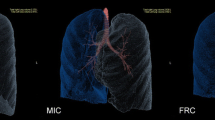Abstract
Background: There is a lack of information on normal inspiratory and expiratory CT lung density in infants. Objective: To describe normal regional CT lung density at end inspiratory and end expiratory lung volumes in children ages 0–5 years. Materials and methods: Motionless HRCT images were obtained at 25 cm (inspiratory) and 0 cm (expiratory) water pressure at apical (top of arch) and basal (2 cm above diaphragm) levels in 16 sedated children (mean age 1.5 years) who underwent CT for reasons other than respiratory disease. Density was measured at anterior–posterior and medial–lateral locations at each level in each lung. The influence of level, location, and age was quantified using analysis of variance methods. Results: Lung density declined linearly in the first few years of life and thereafter approximated adult values. Beginning with the anterior–basal location, density at end inspiration (HU) = −835 − (16 × age in years) + 16 (if apical) + 33 (if posterior) + 23 (if medial) + 14 (if lateral); standard error = 38. At resting end exhalation = −616 − (41 × age) + 50 (if apical) + 155 (if posterior) + 74 (if medial) + 46 (if lateral); standard error = 68. Conclusion: We provide an initial basis for employing lung densitometry in infants and young children at end inspiration and resting end exhalation lung volumes.


Similar content being viewed by others
References
Vock P, Malanowski D, Tschaeppeler H, et al (1987) Computed tomographic lung density in children. Invest Radiol 22:627–631
Ringertz H, Brasch R, Gooding C, et al (1989) Quantitative density-time measurements in the lungs of children with suspected airway obstruction using ultrafast CT. Pediatr Radiol 19:366–370
Stocks J (1996) Measurements during tidal breathing. In: Stocks JSP, Tepper R, Morgan W (eds) Infant respiratory function testing. Wiley, New York, p 34
Castile R, Filbrun D, Flucke R, et al (2000) Adult-type pulmonary function in infants without respiratory disease. Pediatr Pulmonol 30:215–227
Arakawa H, Webb W (1998) Expiratory high-resolution CT scan. Radiol Clin North Am 36:189–209
Rienmuller R, Behr J, Kalender W, et al (1991) Standardized quantitative high resolution CT in lung diseases. J Comput Assist Tomogr 15:742–749
Gevenois P, De Vuyst P, Sy M, et al (1996) Pulmonary emphysema: quantitative CT during expiration. Radiology 199:825–829
Brody A, Klein J, Molina P, et al (2004) High-resolution computed tomography in young patients with cystic fibrosis: distribution of abnormalities and correlation with pulmonary function tests. J Pediatr 145:32–38
Long F, Castile R, Brody A, et al (1999) Lungs in infants and children: improved thin-section CT with a noninvasive controlled-ventilation technique—initial experience. Radiology 212:588–593
de Jong PA, Nakano Y, Lequin M, et al (2003) Estimation of lung growth using computed tomography. Eur Respir J 22:235–238
Long F, Castile R (2001) Technique and clinical applications of full-inflation and end-exhalation controlled-ventilation chest CT in infants and young children. Pediatr Radiol 31:413–422
Fagan D (1976) Post-mortem studies of the semistatic volume-pressure characteristics of infants’ lungs. Thorax 31:534–543
Rosenblum L, Mauceri R, Wellenstein D, et al (1980) Density patterns in the normal lung as determined by computed tomography. Radiology 137:409–416
Wandtke J, Fahey P, Utell M, et al (1986) Measurement of lung gas volume and regional density by computed tomography in dogs. Invest Radiol 21:108–117
Verschakelen J, Van fraeyenhoven L, Laureys G, et al (1993) Differences in CT density between dependent and nondependent portions of the lung: influence of lung volume. AJR 161:713–717
Webb W, Stern E, Kanth N, et al (1993) Dynamic pulmonary CT: findings in healthy adult men. Radiology 186:117–124
Thurlbeck W (1975) Postnatal growth and development of the lung. Am Rev Respir Dis 111:803–844
Wegener O, Koeppe P, Oeser H (1978) Measurement of lung density by computed tomography. J Comput Assist Tomogr 2:263–273
Parr D, Stoel B, Stolk J, et al (2004) Influence of calibration on densitometric studies of emphysema progression using computed tomography. Am J Respir Crit Care Med 170:883–890
Shaker S, Dirksen A, Laursen L, et al (2004) Short-term reproducibility of computed tomography-based lung density measurements in alpha-1 antitrypsin deficiency and smokers with emphysema. Acta Radiol 45:424–430
Author information
Authors and Affiliations
Corresponding author
Additional information
Supported by grants from the Radiological Society of North America and the Cystic Fibrosis Foundation
Rights and permissions
About this article
Cite this article
Long, F.R., Williams, R.S. & Castile, R.G. Inspiratory and expiratory CT lung density in infants and young children. Pediatr Radiol 35, 677–683 (2005). https://doi.org/10.1007/s00247-005-1450-6
Received:
Revised:
Accepted:
Published:
Issue Date:
DOI: https://doi.org/10.1007/s00247-005-1450-6




